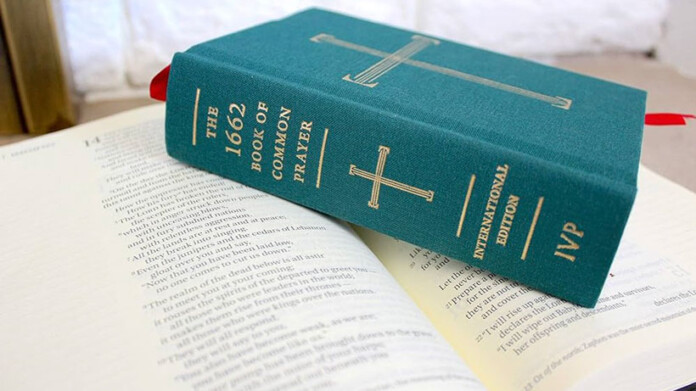How to Use the Book of Common Prayer
A Guide to the Anglican Liturgy
By Samuel L. Bray and Drew Nathaniel Keane
InterVarsity, 192 pages, $18
 Book titles can be tricky. Some are cute and clever, leaving readers wondering what they will find inside. Others appear direct and straightforward, but lead to surprises once the cover is opened. Samuel Bray and Drew Nathaniel Keane’s new work, How to Use the Book of Common Prayer: A Guide to the Anglican Liturgy, falls into the latter category. It’s not that the title is incorrect; the book does indeed provide a thorough guide to the intentions, spirituality, and practical use of the Book of Common Prayer — just not the one you might expect. This book is a user manual to the International Version of the 1662 Book of Common Prayer published by InterVarsity Press in 2021, edited by Bray and Keane.
Book titles can be tricky. Some are cute and clever, leaving readers wondering what they will find inside. Others appear direct and straightforward, but lead to surprises once the cover is opened. Samuel Bray and Drew Nathaniel Keane’s new work, How to Use the Book of Common Prayer: A Guide to the Anglican Liturgy, falls into the latter category. It’s not that the title is incorrect; the book does indeed provide a thorough guide to the intentions, spirituality, and practical use of the Book of Common Prayer — just not the one you might expect. This book is a user manual to the International Version of the 1662 Book of Common Prayer published by InterVarsity Press in 2021, edited by Bray and Keane.
Once that initial confusion is cleared up, the book’s intention becomes quite clear: it introduces non-Anglican evangelicals discovering liturgy for the first time to a venerable and time-tested expression of Christian worship, a solid, stately liturgy with a Reformation edge.
Keane and Bray’s book accomplishes this task admirably, beginning with the reasons for liturgy, how it might be both more biblical and evangelical than modern prejudices might imply, moving to a quick history underscoring the Reformation heritage of the Book of Common Prayer, then exploring the central liturgies with an eye to both page-flipping mechanics (keyed to the page numbers of the International Edition) and the spirituality underpinning these interconnected rites.
While the histories of the various services are touched upon as needed, the focus is consistently on how the praying person can appreciate and internalize the theology and spirituality encoded within the prayer book’s system of devotion. The language is clear and engaging, attentive to the kinds of questions and concerns a loosely Calvinist nondenominational believer might ask upon encountering these liturgies, i.e., how rigid liturgies can also be “prayer of the heart,” and what to make of infant baptism.
As they proceed through Mattins and Evensong, Baptism, and Eucharist, Bray and Keane demonstrate how these 1662 liturgies broadly follow a consistent four-step pattern: keeping liturgies passed down through the ages, simplifying them, pruning away medieval additions and elaborations, and bringing a Reformation emphasis on faith through hearing God’s Word. As they explain the contents and spiritual movements of the liturgies, they continually engage five themes they see as the keys to the Book of Common Prayer: “the gospel, thoroughly catholic and thoroughly reformed doctrine, simplicity, and beauty.” If ever one of these principles is suppressed or soft-pedaled it is, not surprisingly, the “thoroughly catholic” one.
Of course, living into a prayer book requires more than just understanding the text on the page; liturgies are inhabited by communities, and patterns of practice shape how the words are lived. The authors are well aware of this fact, and discuss how the liturgies were used in context. The context they offer is specifically that of the Lutheran-Calvinist blend that marked the early English Reformation, and especially the heritage of the 1552 Protestant revision of the Book of Common Prayer that the 1662 book continues. Accordingly, the authors place an emphasis not only on Mattins and Evensong as the daily prayers of the church, but also central services for the Sunday worship of the community; full Communion services (as opposed to the more common truncated Ante-Communion) are recommended monthly or quarterly, which they correctly note “remained the usual practice of most Anglican churches until the second half of the twentieth century.”
Thus, Bray and Keane have produced a fantastic resource to be studied alongside their International Edition of the 1662 Book of Common Prayer. They introduce its rites and logics to Christians unfamiliar with liturgical practices, who might bring lingering suspicions of fixed rites, explaining how this Scripture-centered worship connects both to the experience of the first Christians and to the Reformation faith informed by Luther and Calvin, Jewell, and Hooker. The focus is never on history for its own sake, but on the gospel-centered theology and spirituality that flow from the long-term immersion within these rites, forming Christians who live their faith in both word and deed.
What is the utility of this book to someone like me, though — a Catholic-leaning Episcopalian committed to the use of the 1979 Book of Common Prayer? As a scholar with an academic interest in the topic and an aficionado of the spectrum of prayer book liturgies, I appreciate this work especially because it challenges my assumptions and presuppositions. As one who learned about the 1662 prayer book at the feet of decidedly Catholic Tractarian and Ritualist luminaries like Blunt, Proctor, Wordsworth, and Frere, the relentlessly Reformation perspective of this guide made me question and re-examine what I thought of these rites, causing me several times to dive into not just the 1662 prayer book, but several of its predecessors as well, to clarify what was being expressed.
I do think the work downplays the rich Catholic heritage of the prayer book tradition, and makes occasional missteps and obfuscations that conceal it. Nods to the early Church and Church Fathers inevitably become citations of Augustine in his Reformation-approved dress. This is perfectly understandable, given the direction of the work and the lingering anti-Catholic sentiment I’m familiar with from many non-denominational believers, but I think opportunities were missed to connect the deep history of the prayer book with the work of the Holy Spirit through the centuries. Ironically, one of the few times this deep history comes up is when it is leveraged against alternate prayer books: the discussion of the eucharistic lectionary of 1662 touts its continuity with the church of the sixth century in order to assert its superiority over the late 20th-century Revised Common Lectionary.
Indeed, it’s inevitable that a work of this kind will draw contrasts between the 1662 book under discussion and the books used by modern Anglican and Episcopal Churches. While comparisons of this kind do occasionally crop up, their purpose is rarely to vilify the current liturgies (apart from a crack at a figurative recent remodeling of the stately Anglican dwelling covering rich wood floors with “linoleum and orange shag carpet”) and they are kept to a minimum; the goal is primarily to promote the 1662 rather than to tear down later editions.
But what of the non-scholar? Will average users of the 1979 or even the 1928 Book of Common Prayer find here inspiration for their spiritual journey? As much as I hate to say it, I suspect the answer is no. First, this work is a guidebook to the International Edition of the 1662 Book of Common Prayer. Without that edition at hand, the book’s purpose as a guide is diminished. Having written a similar guidebook for the 1979 Book of Common Prayer, I know from experience how tightly tied such a guide must be to the text it seeks to explain.
Second, there is, in fact, a gulf between the 1662 edition and the American 1928 and 1979 revisions. The structure and content of the Communion service in the 1662 book directly follows that of the 1552, with reception of the elements directly after the Words of Institution and before the Oblation and praying of the Lord’s Prayer — right in the middle of the Eucharistic prayer from the perspective of the American books. This is because American prayer books have followed the Scottish pattern that hearkens back to the 1549 prayer book, which lacks some of the Reformed elements that characterize both the 1552 and 1662 revisions. As the structure and content differ, so too do the theology and spirituality that flow from it.
Undoubtedly there are nuggets of wisdom and truths about Anglican liturgy generally any believer can find in this guidebook. However, apart from the comparative study of a near relative on the prayer book family tree, I don’t see this work finding much utility in a 1979 or even a 1928 BCP parish.
Dr. Derek Olsen is a biblical scholar and engaged layman in the Episcopal Church.




